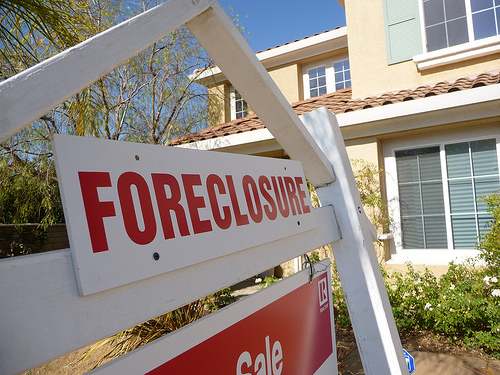Risky Mortgage Program Resurfaces in Congress
Advocates and economists say any support for such a program reflects how some lessons of the housing crisis were not learned.
Jul 31, 2020808.2K Shares13M Views
Flickr: respres
A housing program blamed in part for high default rates on government-backed loans, derided as a “scam” by the Internal Revenue Service and targeted for years for elimination by the agency that ran it looked like it finally had reached its end this fall, after Congress finally banned it. But now, in a sign that some lessons of the housing crisis have yet to be learned, a movement is afoot to bring it back.
The program is called seller-funded down payment assistance. When U.S. Department of Housing and Urban Development Secretary Shaun Donovan toldCongress last month that dramatic growth in seller-funded down payment assistance programs in recent years had added to high default rates on Federal Housing Administration-backed loans, it might have seemed like the final blow. The programs, initially intended to help low and moderate income people buy homes, had long been under fire, the subject of complaints from HUD, the General Accounting Office, and the IRS. And with FHA default rates threateningto trigger yet another taxpayer bailout, policymakers have plenty of motivation to steer clear of any lending approaches deemed risky or problematic.
Illustration by: Matt Mahurin
But supporters of seller-funded down payment assistance aren’t giving up. Despite Donovan’s stance, they’re still supporting a bill to revive the program – a measurenow before the House Financial Services Committee. Sponsored by Rep. Al Green (D-Tex.), the bill has 17 co-sponsors, among them powerful lawmakers such as Rep. Maxine Waters (D-Calif.). Backers include builders and realtor groups, the National Association of Mortgage Bankers, and the Congressional Black Caucus. Committee Chairman Barney Frank, D-Mass., toldthe Wall Street Journal last year he wants to reform the program, not kill it. And supporters are continuing to pressure HUD to preserve it.
“We do agree there were problems with the previous program,” said David Ledford, senior vice president for housing policy at the National Association of Home Builders.“But we still support the legislation. HUD was somewhat at fault for not properly monitoring it. It can be done more carefully, and with tighter controls. But HUD is just throwing up its hands and saying things turned out badly and we shouldn’t do it at all.”
But Ledford’s views aren’t widely shared by many in the mortgage industry, and they simply don’t reflect reality, according to the program’s numerous critics. FHA’s seller-funded down payment assistance should have ended years ago, given ample evidence of its problems, said Guy Cecala, publisherof Inside Mortgage Finance, a Bethesda, Md. company that covers the lending industry. The GAO concludedthat homes purchased using the programs were appraised at and sold for 2 to 3 percent more than comparable homes bought without the assistance. The IRS in 2006 revokedthe tax-exempt charitable status of providers of seller-funded down payment assistance – and called the programs “scams.” HUD’s Inspector General and the FHA itself have complainedthe programs raise home ownership costs and lead to more foreclosures, saying homeowners using the assistance were two to three times more likely to default on payments than other borrowers.
Both the FHA and HUD allow homebuyers to receive downpayment money from third parties, such as relatives, employers, government agencies and independent nonprofits. But unlike much of the rest of the mortgage industry, the FHA also allowed homeowners to get downpayment help from nonprofits or charities funded in part by sellers. And that’s where the problems came in.
In a speech last summer, former FHA Commissioner Brian Montgomery calledseller-funded down payment assistance programs “circular financing schemes.” Property sellers often raised the sales price of a home to cover the cost of downpayment “gift,” the GAO noted. The charity or nonprofit that supplied the down payment money was reimbursed by the seller for it, along with service costs and fees, once the deal closed. Borrowers unwittingly paid for it all. Criticscontended some charities existed solely to funnel the downpayment money from the seller to the buyer. The program was especially popular with builders.
The Mortgage Lender Implode-O-Meter, an influential financial blog leading a blogosphere campaignagainst reinstating the downpayment program, explainedthat buyers qualified for FHA loans using grant letters from the charities as proof of downpayment. As far as the FHA was concerned, the grant was a charitable donation that came from an independent nonprofit, and not the seller.
“„Suckers!…Of course the losers in this scheme are the FHA (the taxpayer –who actually has to insure these loans), and ultimately the borrower — who is probably already underwater and overextended.
After buyer lawsuits, rising defaults, and other controversies, Congress finally endedthe practice as part of the mortgage rescue package approved last summer, and the programs were banned as of Oct. 1. The bill to revive them is a long shot to eventually become law, given the past controversies. But the fact that a campaign even exists means one of the biggest lessons of the financial meltdown – that buying homes with no money down isn’t exactly a great idea – seems to be lost, at least on some.
“It’s a program that HUD doesn’t really want, the mortgage industry doesn’t really want and most community groups don’t really want,” Cecala said. “It’s got such a lousy track record. That anyone would want to resurrect it at all is astonishing.”
Added Cecala: “The fact that Congress would even consider this… are these guys serious? Did they do any research on this at all? It should have a skull and crossbones on it.”
Dean Baker,co-director of the Center for Economic Policy and Research, who warned before the financial crisis of a growing housing bubble, expressed similar sentiments. “I’d say it’s a bad idea that won’t go away,” Baker said. “I think it’s basically crazy. Arguably one of the lessons we were supposed to have learned is that we shouldn’t have been pushing homeownership, everywhere and always.”
“It’s a long shot to become law, but I wouldn’t rule it out. You have some big groups pushing it on the other side.”
Seller-funded down payment programs drew little attention earlier in the decade, when the FHA had a much smaller share of the mortgage market, and when helping low-income borrowers get into homes was an aggressive public policy goal, noted Patricia McCoy,a University of Connecticut law school professor who specializes in banking and securities regulation.
But use of the programs increased sharply, after the subprime meltdown led to an expansion of FHA-backed lending. And last month, HUD Secretary Donovan toldCongress that while loans with seller-funded down payment assistance represented only 12 percent of the FHA portfolio at the start of 2008, they accounted for 30 percent of all foreclosures completed that year. He said the end of the program “should substantially reduce FHA losses on new originations in the years ahead.”
Some large down payment assistance providers, however, are countering with a campaign that contends the ban is hurting working class Americans, who want to buy homes but can’t come up with steeper downpayments because of tightened lending standards. A website sponsored by the bill’s supporters refersto the measure as “DPA Reform” and includes a running tally of the number of Americans denied access to homeownership since the programs officially ended.
Ann Ashburn, president of AmeriDream,a Gaithersburg, Md. provider, said in a statement last fall that “eliminating charitable down payment assistance will slam the door on over 100,000 teachers, firefighters, working families and others who rely on these programs annually to become homeowners.”
AmeriDream spokesman Henry Fawell said the company is “cautiously optimistic” about prospects for reviving the program. Helping buyers with downpayments would benefit the economy as a whole and could jump start the housing market, he said. Vacant homes are scarring neighborhoods with blight, but many borrowers can’t come up with downpayments on their own to buy them, he said.
Fawell acknowledge problems with the programs in the past, but said the new bill addresses them by including requirements for higher credit scores, fees for riskier borrowers, and penalties for inflated appraisals. “We have support on both sides of the aisle,” Fawell said.
With the Obama administration busy handling banks stress tests, bailouts and financial regulatory reform, the bill to reinstate seller-funded down payment assistance isn’t facing much active lobbying opposition. And down payment providers and housing lobbyists have a long history of successfully fighting off attempts to end the programs. HUD began trying to do so back in 1999 and again in 2007, when it was successfully suedby AmeriDream and by the Nehemiah Corp. of America, another large provider. Barely 24 hours after Congress approved the ban last summer, Rep. Green introduceda measure to bring it back.
One possibility is that supporters could slip in reinstatement of the program into a larger housing bill. But Cecala, of Inside Mortgage Finance, thinks it’s still a hard sell. Putting people in homes with no money down is a widely discredited idea, he said. Although civil rights groups still support the programs, the thinking has changed regarding the best approach to help minority borrowers.
“The Community Reinvestment Act and other programs are a much more sustainable way to get people into homes as opposed to subprime and no-downpayment FHA loans,” Cecala said. “But they also are a lot more work for both the lenders and borrowers.”
In the meantime, Ledford, of the builders’ association, said his group is working with HUD to see if first-time homebuyers can apply some of the new $8,000 tax credittoward downpayments. HUD is trying to make sure some of the same circular financing problems that plagued the seller-funded down payment assistance program wouldn’t affect that proposal, he said.
It seems that when it comes to seller-funded down payment assistance, the fight never really ends.
*Correction: The Mortgage Bankers Association does not support seller-funded downpayments, as was incorrectly reported in the original version of this story . The National Association of Mortgage Bankers does support seller-funded downpayments. We regret the error. *

Paolo Reyna
Reviewer
Paolo Reyna is a writer and storyteller with a wide range of interests. He graduated from New York University with a Bachelor of Arts in Journalism and Media Studies.
Paolo enjoys writing about celebrity culture, gaming, visual arts, and events. He has a keen eye for trends in popular culture and an enthusiasm for exploring new ideas. Paolo's writing aims to inform and entertain while providing fresh perspectives on the topics that interest him most.
In his free time, he loves to travel, watch films, read books, and socialize with friends.
Latest Articles
Popular Articles

